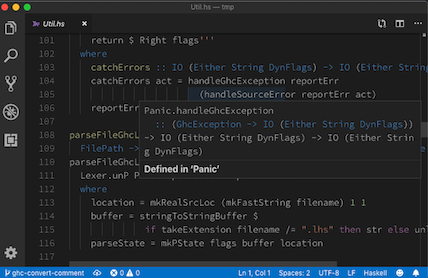* Support depending on potentially stale values in damlc For now, this is opt-in and only enabled for the scenario service. Locations should be properly mapped so if lines are inserted above a scenario, the scenario link will move down. |
||
|---|---|---|
| exe | ||
| extension | ||
| img | ||
| src/Development/IDE | ||
| test | ||
| .ghci | ||
| .gitignore | ||
| BUILD.bazel | ||
| hie-core-daml.sh | ||
| hie-core.cabal | ||
| hie.yaml | ||
| install.bat | ||
| README.md | ||
| stack.yaml | ||
hie-core (Haskell IDE engine)
Our vision is that you should build an IDE by combining:

hie-biosfor determining where your files are, what are their dependencies, what extensions are enabled and so on;hie-core(i.e. this library) for defining how to type check, when to type check, and producing diagnostic messages;- A bunch of plugins that haven't yet been written, e.g.
hie-hlintandhie-ormolu, to choose which features you want; haskell-lspfor sending those messages to a Language Server Protocol (LSP) server;- An extension for your editor. We provide a VS Code extension as
extensionin this directory, although the components work in other LSP editors too (see below for instructions using Emacs).
There are more details about our approach in this blog post.
Using it
Install hie-core
First install the hie-core binary using stack or cabal, e.g.
git clone https://github.com/digital-asset/daml.gitcd daml/compiler/hie-corecabal installorstack install(and make sure~/.local/binis on your$PATH)
It's important that hie-core is compiled with the same compiler you use to build your projects.
Test hie-core
Next, check that hie-core is capable of loading your code. Change to the project directory and run hie-core, which will try and load everything using the same code as the IDE, but in a way that's much easier to understand. For example, taking the example of shake, running hie-core gives some error messages and warnings before reporting at the end:
Files that worked: 152
Files that failed: 6
* .\model\Main.hs
* .\model\Model.hs
* .\model\Test.hs
* .\model\Util.hs
* .\output\docs\Main.hs
* .\output\docs\Part_Architecture_md.hs
Done
Of the 158 files in Shake, as of this moment, 152 can be loaded by the IDE, but 6 can't (error messages for the reasons they can't be loaded are given earlier). The failing files are all prototype work or test output, meaning I can confidently use Shake.
The hie-core executable mostly relies on hie-bios to do the difficult work of setting up your GHC environment. If it doesn't work, see the hie-bios manual to get it working. My default fallback is to figure it out by hand and create a direct style hie.yaml listing the command line arguments to load the project.
Once you have got hie-core working outside the editor, the next step is to pick which editor to integrate with.
Using with VS Code
Install the VS code extension (see https://code.visualstudio.com/docs/setup/mac for details on adding code to your $PATH):
cd compiler/hie-core/extensionnpm cinpm install vsce --global(may requiresudo)vsce packagecode --install-extension hie-core-0.0.1.vsix
Now openning a .hs file should work with hie-core.
Using with Emacs
The frst step is to install required Emacs packages. If you don't already have Melpa package installation configured in your .emacs, put this stanza at the top.
;;Melpa packages support
(require 'package)
(let* ((no-ssl (and (memq system-type '(windows-nt ms-dos))
(not (gnutls-available-p))))
(proto (if no-ssl "http" "https")))
(when no-ssl
(warn "\
Your version of Emacs does not support SSL connections,
which is unsafe because it allows man-in-the-middle attacks.
There are two things you can do about this warning:
1. Install an Emacs version that does support SSL and be safe.
2. Remove this warning from your init file so you won't see it again."))
;; Comment/uncomment these two lines to enable/disable MELPA and MELPA Stable as desired
(add-to-list 'package-archives (cons "melpa" (concat proto "://melpa.org/packages/")) t)
;;(add-to-list 'package-archives (cons "melpa-stable" (concat proto "://stable.melpa.org/packages/")) t)
(when (< emacs-major-version 24)
;; For important compatibility libraries like cl-lib
(add-to-list 'package-archives (cons "gnu" (concat proto "://elpa.gnu.org/packages/")))))
(package-initialize)
;; Remember : to avoid package-not-found errors, refresh the package
;; database now and then with M-x package-refresh-contents.
When this is in your .emacs and evaluated, M-x package-refresh-contents to get the package database downloaded and then M-x package-list-packages to display the available packages. Click on a package to install it. You'll need to install the following packages:
lsp-haskelllsp-uiflycheckyasnippet
When done with this, add the following lines to your .emacs:
;; LSP support for Haskell
(require 'lsp)
(require 'lsp-haskell)
(require 'yasnippet)
(add-hook 'haskell-mode-hook #'lsp)
(setq lsp-haskell-process-path-hie "hie-core")
(setq lsp-haskell-process-args-hie '())
Optionally, you may wish to add the following conveniences:
;; Enable LSP logging (helpful for debugging)
(setq lsp-log-io t)
;; Keyboard mappings for goto next/previous error
(define-key flymake-mode-map (kbd "M-n") 'flymake-goto-next-error)
(define-key flymake-mode-map (kbd "M-p") 'flymake-goto-prev-error)